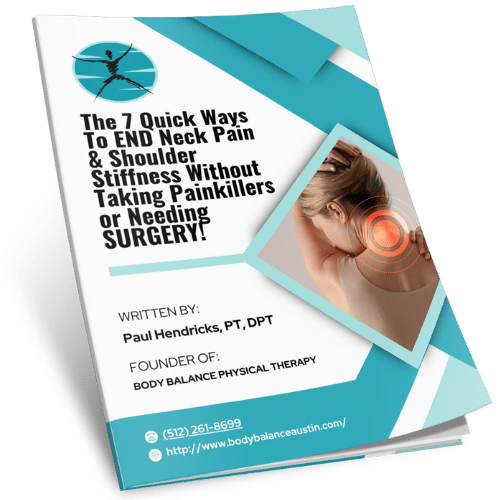How To Put an End To Shoulder Pain
Nagging Shoulder Pain Holding You Back?
Don’t let shoulder pain ruin your day — Physical Therapy can help
Different Types Of Shoulder Pain
Click The Button Below To Learn How We Can Help Your Shoulder Pain!

Does This Sound Like You?
Are you having pain trying to reach above your head?
When your shirt comes untucked in the back, are you able to easily reach back and tuck it in?
Is the pain in your shoulder waking you up at night?
Are you not sure what your next step should be?
Shoulder pain not only hurts, but it also limits the use of our elbow and hand.
Our Lakeway, Dripping Springs, and South Austin physical therapists are trained in diagnosing shoulder issues and performing interventions to help to get rid of your pain and restore your ability to use your arm fully again.
Understanding why you have Shoulder Pain
The shoulder is an elegant piece of machinery. It has the greatest range of motion of any joint in the body.
However, this large range of motion can lead to joint problems.
Understanding how the different layers of the shoulder are built and connected can help you understand:
- how the shoulder works,
- how it can be injured
- how challenging recovery can be when the shoulder is injured.
The deepest layer of the shoulder includes the bones and the joints. The next layer is made up of the ligaments of the joint capsule. The tendons and the muscles come next.
A shoulder injury can happen in any sport, and shoulder pain can be brought on from something as simple as sleeping in the wrong position.
Whether you have damaged your rotator cuff because you were a little too overzealous at touch football with your friends on Sunday, or you are sore from trying to weed the garden and paint the garage in one afternoon,
Request A Call Back from a Physical Therapist
If you’re not quite ready to book an appointment yet and have some questions you would like answered first, click the link below to complete a form to get the conversation started.


How can We Help?
It is our aim to provide you with the information and tools to help you recover from a shoulder injury and to prevent future injuries from occurring. When you have proper information about how to stay healthy, you will find that your activities will be more rewarding, your sleep with be more sound and your daily grind won’t wear you down. We work with you and help you on every milestone of your journey to get you back to the things you lovely quickly and with lasting results.
Common Reasons for Shoulder Pain?
- Tendonitis - Tendinitis occurs when the shoulder joint is excessively overused typically due to the physical demands of a person’s job, overhead activity, or sport. Another factor for tendinitis is also poor posture because this alters the normal forces on the tendons, and can set you up for tendon injury. This causes the tendons to undergo ongoing inflammation, resulting in swelling and painful impingement when raising your arm.
- Frozen Shoulder - Frozen shoulder results in a painful loss of motion in the shoulder with a tightening of the shoulder joint that severely limits motion. It is also known as “adhesive capsulitis.” This condition can occur if your arm has been in a cast or sling for a while, or if you have been bedridden for an extended period of time. Some ethnicities are more predisposed, and women from 40-60 years of age tend to have more instances of this condition than men.
- Rotator Cuff Tear - A rotator cuff tear is a shoulder injury where the tendons supporting movement and stability tear, causing pain and weakness. It can result from overuse, heavy lifting, or injury, with treatment ranging from therapy to surgery.
- Impingement - Impingement typically occurs because of abnormal movement and tracking of the humeral head as you lift your arm overhead. Pain typically occurs when lifting your arm at or above 90 degrees.
- Arthritis - The two main forms of arthritis that affect the shoulder are osteoarthritis and rheumatoid arthritis. Both of these result in loss of motion, weakness to the shoulder muscles, and difficulty performing normal, daily tasks.
- Rheumatoid Arthritis - Rheumatoid arthritis occurs when the immune system decides to attack the membranes surrounding the shoulder joint, resulting in pain and inflammation.
- Osteoarthritis - Osteoarthritis occurs when the cartilage in the shoulder joint experiences significant “wear and tear,” typically due to age or excessive overuse.
Request A Free Discovery Visit
Are you unsure if physical therapy is right for you? Take advantage of our FREE discovery visits which help identify your issues and if we can provide help!
** Please note there is no treatment given during one of our discovery visits. These visits are designed to evaluate your needs and ensure we can offer the help you need.
Surgery vs Physical Therapy
Those who experience rotator cuff injuries or “torn shoulders” generally report a dull ache deep in their shoulder, arm weakness, difficulty reaching behind their backs, and disturbed sleep due to pain.
Depending on the severity and situation, sometimes surgery is needed, but often the correct physical therapy treatments can help reduce pain and restore strength to the rotator cuff to compensate for the partial tear.
If surgery is needed, physical therapy is an integral part of the rehabilitation to a full recovery.
According to the American Physical Therapy Association, “A recent study from Finland asserts that when it comes to the treatment of nontraumatic rotator cuff tears, physical therapy alone produces results equal to those produced by arthroscopic surgery and open surgical repair.”
At Body Balance Physical Therapy, our natural and non-invasive methods can help relieve your shoulder pain and heal your rotator cuff injury.
Why Are Our Shoulders So Important?
The shoulder is a “ball-and-socket” joint, meaning the head of the upper arm bone, or “humerus,” fits perfectly in the corresponding space within the shoulder blade or “scapula.” The ends of the bone are protected by a thick layer of cartilage, protecting the bones from rubbing together.
Fluid-filled sacs called “bursae” also protect the tendons from rubbing against the bones.
Tendons attach the bones in the shoulder to a set of bones, known as the rotator cuff.
Your shoulders are capable of accomplishing tons of physical features.
The shoulders have the greatest range of all the joints in your body!
However, with its complexities also comes the possibilities of pain and discomfort.
The type of pain you feel in your shoulder can vary, depending on what is causing it.
Pain from impingement, for example, typically occurs as you raise your arm up, and begins at a certain point in the range of motion.
Pain resulting from a degenerated shoulder may create persistent aches every time you move your arm in certain directions.
Acute injuries can result in sudden and intense pains that make it impossible for you to move your shoulder at all. If something goes wrong with the intricacies that make up the mechanical interplay of the shoulder, pain can be the unfortunate result.
Need To Know More About Cost and Availability?
If you’d like to find out more information about the cost and availability of our services click the button below to complete a short form, a member our team will then reach out.
What is physical therapy treatment for Shoulders pain like?
Physical therapy is a natural, easy, and comfortable way to find relief for shoulder pain, without the need for harmful drugs or invasive surgery. Our Lakeway and South Austin/Onion Creek physical therapists have treated a number of conditions resulting in shoulder pain, with patients finding improvement and relief after just a few short sessions.
Physical therapists are movement experts who are trained to pinpoint the cause of your pain through a variety of diagnostic tests and methods.
During your evaluation, we will examine your range of motion, strength, coordination, medical history, joint mobility, and mechanics of your joint motion.
After your physical therapist has established the cause of your shoulder pain, they can create a specialized combination of physical therapy methods to manage and relieve your pain.
Your treatment plan may involve gentle manual therapy, which helps to restore normal joint movement, ease soft tissue restrictions, and promote circulation. It could also include specific therapeutic exercises to restore strength and the correct sequence of muscle activation around the shoulder joint.
Another benefit of physical therapy is that you’ll learn new ways to move your body to enhance your strength and to prevent the recurrence of future shoulder problems.

